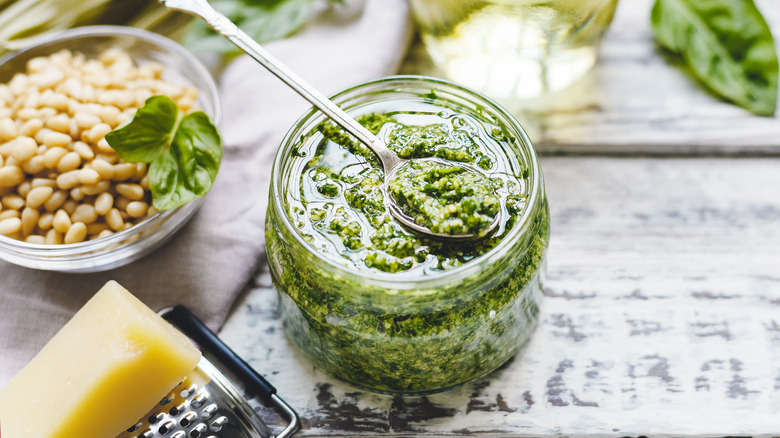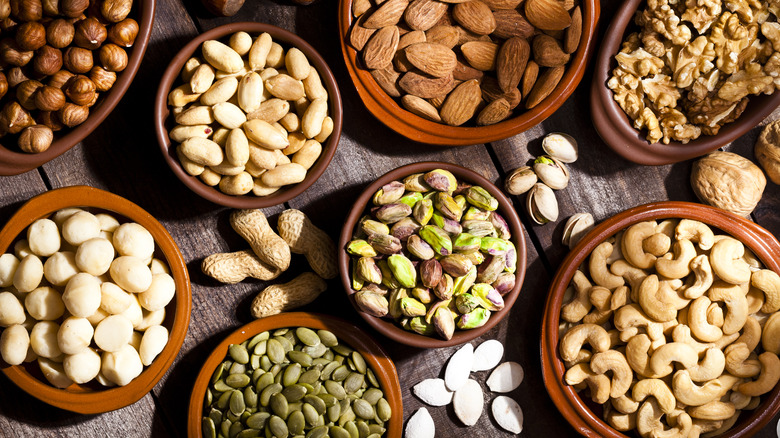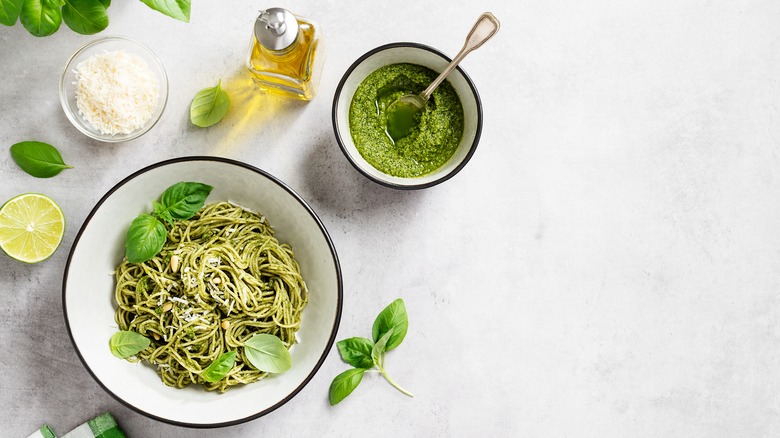The Best Pine Nut Substitute When You're Having A Pesto Emergency
If you find yourself in a pesto emergency and need to sub something for pine nuts in a pinch, look no further than your pantry. Cashews reign as the internet's answer due to their similarities in flavor and texture. Like pine nuts, cashews are actually seeds (called drupe seeds) that grow on the fruit of cashew plants native to Brazil. But if you don't have cashews on hand, other nuts and seeds will do.
So, what are pine nuts? The teardrop-shaped beige colored pine nuts (pinoli in Italian) are the edible seed of pine cones famous for their subtly sweet, slightly nutty and buttery taste and creamy texture. Several species of pine trees exist, but only about 20 produce seeds that are harvested for local or international consumption. Pine nuts are the second most costly nut (seed, really) on the market (the macadamia nut is first) due to the long maturity times for the producing trees, an incredibly labor-intensive harvesting process, the global increase in demand, and rising food costs. Perhaps a more cost-effective and sustainable substitute might fare better, anyway.
Of course, which pine nut substitute you need depends on what you're making. For the classic Italian pesto, cashews could be the answer. Many regional variations of pesto exist, such as Sicily's pesto alla Trapanese. But for this post, we'll explore the classic basil preparation, pesto alla Genovese, traditionally made with basil, garlic, olive oil, Parmigiano Reggiano and Pecorino Fiore Sardo, salt, and you guessed it ... pine nuts.
The best pine nut substitutes
So, what are the best pine nut substitutes for pesto? According to The Pioneer Woman, common substitutes include cashews, pistachios, walnuts, almonds, and hazelnuts, in addition to others. Cashews are the most obvious choice because they're slightly nutty and creamy. And when thoroughly chopped, they can pass for pine nuts in a pesto emergency. Go with the unsalted kind, and toast them at home for a more robust flavor. Similar to cashews, almonds make another great substitute with their mildly sweet flavor. Soak them overnight to soften their texture and take away any bitterness.
Perhaps a more authentic substitute for pine nuts in pesto are walnuts. Persian traders introduced walnuts to the Ligurian region some 1,000 years ago. It is fitting that this Mediterranean haven boasting the port city of Genoa from which pesto alla Genovese hails is also home to another classic pesto, salsa di noci, or Ligurian walnut sauce. So while making basil pesto sans pine nuts, consider chopped walnuts as a more regionally appropriate substitute. The Pioneer Woman suggests toasting them slightly and soaking overnight in water once cooled to further enhance the nutty flavor and remove the skins which contain the bitter flavor.
Finally, pistachios add an exciting spin on the classic, introducing a slightly different flavor and a vibrant green color.
A brief history of Liguria's most iconic sauce
Pesto's humble roots date back to the ancient Romans, who ground herbs into a paste along with garlic, cheese, olive oil, and vinegar using a mortar and pestle, a process they called "moretum,"which loosely translates to salad in Latin. Other greens may have been added as well, and the mixture was typically served with bread.
The Romans also introduced basil to the Mediterranean. The hand-harvested crop grows in densely packed fields throughout Liguria. The best of this Genovese basil, or "Basilico Genovese," is believed to come from the city of Pra. Internationally revered, Basilico Genovese received a DOP certification from the European Union in 2006. The first pesto recipe appeared in the third edition of "La Cuciniera Genovese" by Gio Batta Ratto, published in 1863. In 1865, a cookbook authored by Emmanuel Rossi renamed it pesto alla Genovese. Derived from the Italian verb "pestare," meaning to crush, grind, or pound , "pesto" may also refer to a pestle, which is traditionally used along with a mortar to mash the ingredients.
So before you fret about the absence of pine nuts while making your next batch of pesto, solve your pesto emergency with more readily available substitutes. Chances are your guests won't notice the difference.


